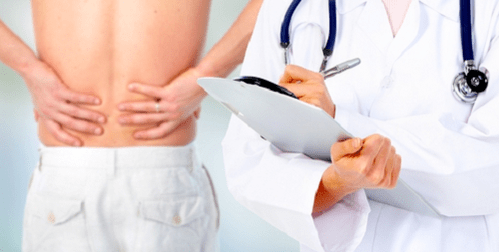Sudden, acute, sore or dull low back pain radiating to the legs, the cause of which cannot always be identified immediately, may indicate the development of various diseases. Only an experienced physician can understand exactly what caused the pain syndrome after examining the clinical picture, the patient’s complaints, and the results of ultrasound, x-ray, or MRI scans and analyzes. But often, before you go to the doctor, you want to know in advance what your condition is related to.

The main causes of lumbar pain
First, each cause of back pain can be divided into two main types:
- Primary (pain is precisely related to pathology of the spine, intervertebral discs, muscle tissue, or joints).
- Secondary (pain occurs with pathologies of the internal organs and occurs in the lower back, as well as due to infectious diseases of the body, the development of tumors).
Primary causes of back pain
Nowadays, walking on two legs is called the cause of all the problems in the spine. The load on the spine increases greatly with the vertical position of the body, especially in the lower part - the groin, which wears out faster.
The main causes of back pain are:
- Osteochondrosis of the lumbar spine. Degenerative lesions of the spine cause acute pain, inflammation, swelling in the affected area, and difficulty moving. The characteristic changes in the cartilage tissue of the cartilage discs and in the vertebral bodies themselves often cause nerve entrapment, which manifests itself in acute pain.
- Spondyloarthrosis. This pathology affects the joint tissue in the region of the spine. In addition to joint pain, a person with spondyloarthrosis may experience severe stiffness when it is impossible to straighten or turn.
Lumbar pain caused by osteochondrosis or spondyloarthrosis requires urgent, immediate medical attention and, of course, immediate treatment.
Secondary low back pain
Many diseases not related to the pathological processes of the spine can cause unpleasant back pain.
There are secondary causes of low back pain, such as:
- curvature of the spine (scoliosis, lordosis, etc. );
- infections of various origins affecting the intervertebral discs (tuberculosis, etc. );
- the consequences of urinary tract infections and influenza;
- inflammatory processes in the genitals;
- gastrointestinal disorders (appendicitis, pancreatitis, cholecystitis, intestinal colic);
- kidney disease;
- oncological diseases localized in the perilumbar region;
- overweight;
- osteoporosis, acute rheumatism, chronic arthritis;
- prolonged standing or sitting;
- muscle cramp;
- nervous tension.
Diseases of the internal organs have their own vivid symptoms that are only reflected in the lower back.
Causes of low back pain in women and men
The structure of the female body tends to show difficulty and pain in the lumbar region. This is due to the hormonal background: the menstrual cycle, menopause, and pregnancy affect the lumbar region because the reproductive organs are located in close proximity. Gynecological diseases (appendicitis and uterine inflammation) cause radiant low back pain in women.
Similarly, in men, inflammation of the prostate and epididymis cause pain. Men sometimes have back pain while working in the constant cold, in drafts, or when the work involves lifting weights. Such causes of back pain require preventive measures: you need to warm your back and wear special corsets.
Muscle clamps
I would like to specifically mention a moment like muscle cramps, which are often the cause of lower back pain. A constant lack of physical activity leads to the fact that the back muscles are weak and unable to withstand prolonged or increased loads. Therefore, working on your legs or in a still sitting position will strain your back muscles and cause pain.
Stress has the same effect when muscle tension is created by fear or anger. This is followed by cramps and pain if not eliminated in time.
Concomitant symptoms
Low back pain, which is caused by a change in the spine, most often has the following symptoms:
- the discomfort may not only cover the back but may also penetrate the buttocks and lower extremities;
- movement can be very difficult or completely impossible;
- the affected area is usually inflamed and swollen.
You should seek medical attention from a neurologist for any of these symptoms. If you have other accompanying symptoms, it is better to contact a therapist who will determine the causes of your back pain and then refer you to a specialist or prescribe treatment.













































